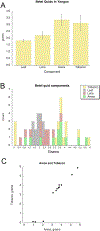Betel Nut (areca) and Smokeless Tobacco Use in Myanmar
- PMID: 31220988
- PMCID: PMC7774082
- DOI: 10.1080/10826084.2019.1624774
Betel Nut (areca) and Smokeless Tobacco Use in Myanmar
Erratum in
-
Correction.Subst Use Misuse. 2019;54(14):2425. doi: 10.1080/10826084.2019.1665781. Epub 2019 Sep 24. Subst Use Misuse. 2019. PMID: 31778103 No abstract available.
Abstract
Background: Betel nut (areca) is the world's fourth most commonly used addictive substance. Arecoline, a muscarinic agonist in areca, is also a partial agonist for the addiction-related high-affinity brain nicotine receptors. In many countries, smokeless tobacco is commonly mixed with areca. Objective: We sought to evaluate the knowledge of self-harm, and addiction associated betel quid use in an unban population. Methods: We conducted a survey study of 200 betel quid users in Yangon, Myanmar, and a survey of betel quid vendors to determine the relative amounts of areca and tobacco in the available quids. Results: The data determined that a large majority of the survey subjects (84%) used tobacco with their areca. Users had a general awareness that betel chewing was "a bad habit" (85%) and 80% were aware of the cancer risks. Understanding areca addiction remains a challenge since, aside from the strong muscarinic activity of arecoline stimulating salivation, overt neurologic effects are difficult for even the users to identify. Fifty eight percent of the respondents indicated that chewing betel quid had effects like drinking coffee, and 55.5% indicated that it had effects like drinking alcohol. Data obtained from the quid vendors indicated that 75% added tobacco in equal amounts to areca. Conclusion: The concomitant use of nicotine and areca indicates that betel quid addiction includes a significant component of nicotine dependence. However, the additional activities of areca, including the muscarinic effects of arecoline, indicate that potential cessation therapies should optimally address other factors as well.
Keywords: Areca; addiction; cancer; cessation therapy; drug dependence; tobacco.
Conflict of interest statement
Disclosure statement
No potential conflict of interest was reported by the authors.
Figures




References
-
- Auluck A, Hislop G, Poh C, Zhang L, & Rosin MP (2009). Areca nut and betel quid chewing among South Asian immigrants to Western countries and its implications for oral cancer screening. Rural Remote Health, 9, 1118 Retrieved from http://www.ncbi.nlm.nih.gov/pubmed/19445556 - PMC - PubMed
-
- Bachman SA (2013). Betel nut product characteristics and availability in King County, Washington: A secret shopper study (M. P. H.). Seattle, WA: University of Washington; Retrieved from http://hdl.handle.net/1773/24272
MeSH terms
Grants and funding
LinkOut - more resources
Full Text Sources
Medical
Research Materials
